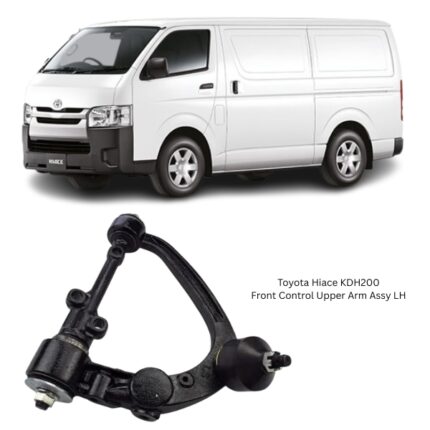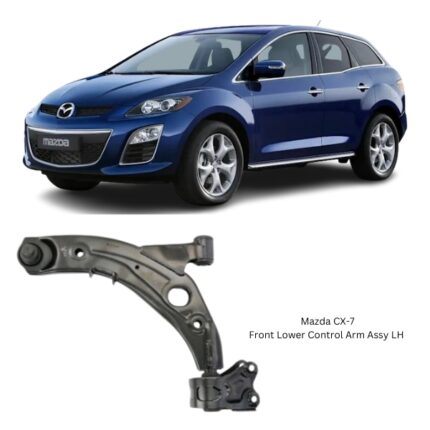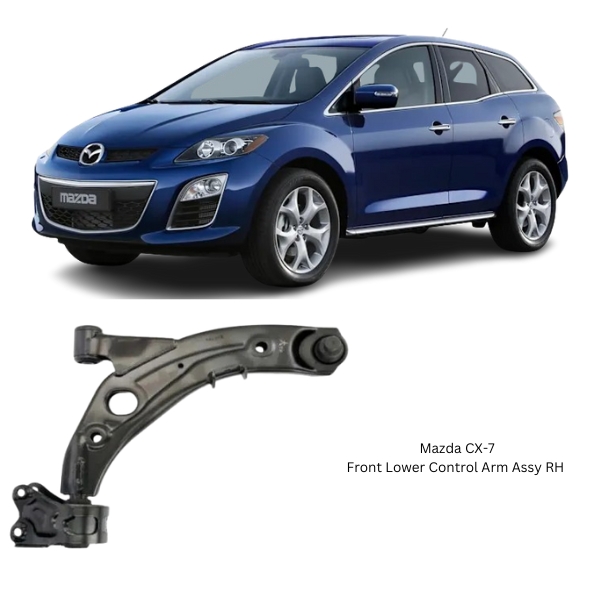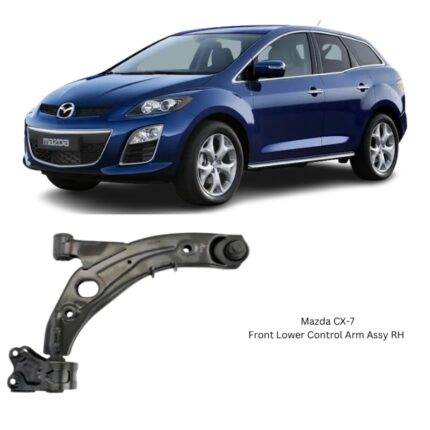Get Mazda CX-7 Front Lower Control Arm Assy RH EG21-34-300D in Kenya
The Front Lower Control Arm Assembly RH (Right-Hand) is a fundamental component in a vehicle’s front suspension system. Located on the right-hand (passenger’s) side, this part plays a critical role in ensuring stability, steering accuracy, and ride comfort. Acting as a structural bridge between the wheel hub and the vehicle’s frame or subframe, the lower control arm maintains proper wheel alignment, enables controlled vertical wheel motion, and supports a range of driving dynamics from cornering to braking.
Understanding its function, structure, common failure symptoms, and maintenance requirements is essential for technicians, vehicle owners, and automotive parts professionals.
1. What Is the Front Lower Control Arm Assembly RH?
The Front Lower Control Arm Assembly RH is a suspension component mounted between the vehicle’s frame and the lower portion of the steering knuckle on the front-right side. It controls the motion of the wheels, allowing them to move up and down in response to the road surface while maintaining lateral alignment and structural support.
In vehicles with independent front suspension, especially those using MacPherson struts or double-wishbone systems, the lower control arm provides the main mounting point for the wheel assembly and absorbs significant loads from the road and vehicle dynamics.
2. Components of the Front Lower Control Arm Assembly
A complete control arm assembly generally consists of:
-
Arm Body: Often forged steel, cast iron, or aluminum, engineered to be rigid and durable.
-
Bushings: Rubber or polyurethane inserts that cushion the arm’s connection to the chassis, reducing vibration and noise.
-
Ball Joint: A pivotal spherical joint at the outer end of the control arm that connects to the steering knuckle and allows for wheel articulation during turns.
-
Mounting Hardware: Includes bolts, washers, and brackets necessary for secure installation to the subframe and chassis.
3. Function of the Lower Control Arm Assembly RH
a) Maintaining Wheel Position
It ensures that the wheel remains properly aligned under dynamic conditions—when the suspension compresses or extends—preserving steering geometry and minimizing tire wear.
b) Enabling Vertical Movement
The control arm allows the wheel to move up and down independently of the chassis, absorbing impacts from bumps, potholes, and rough terrain.
c) Connecting Suspension Components
The lower control arm provides mounting points for the strut or coil spring and the stabilizer bar, forming a key structural element of the suspension.
d) Steering and Handling Support
By housing the ball joint, it plays an active role in the steering system, allowing the knuckle to pivot during turns.
4. Benefits of a High-Quality Front Lower Control Arm RH
-
Improved Handling and Stability: Maintains correct camber and caster angles, which enhances control during cornering and lane changes.
-
Reduced Tire Wear: Keeps tires properly aligned, minimizing irregular or premature tread wear.
-
Increased Ride Comfort: Quality bushings absorb shocks and vibrations, leading to a smoother and quieter ride.
-
Enhanced Safety: Maintains steering geometry and braking stability.
-
Longer Service Life: Durable construction resists fatigue, rust, and deformation, especially in high-stress environments.
5. Symptoms of a Worn or Damaged Front Lower Control Arm RH
Recognizing signs of failure can prevent further damage and ensure safety:
-
Clunking or Knocking Noise – Often heard when driving over bumps or during sharp turns, caused by worn bushings or loose ball joints.
-
Steering Wander or Pulling – The vehicle may drift to one side or require constant correction.
-
Vibration in the Steering Wheel – Particularly noticeable at high speeds due to excessive play or misalignment.
-
Uneven Tire Wear – Camber changes caused by damaged control arms can lead to feathering or excessive wear on one side of the tire.
-
Poor Braking Stability – The car may nose-dive or feel unstable under hard braking.
6. Common Causes of Control Arm Damage
-
Normal Wear and Tear: Over time, bushings and ball joints degrade due to continuous movement and exposure to the elements.
-
Road Impacts: Striking curbs, potholes, or speed bumps at high speed can bend or crack the control arm.
-
Corrosion: Salt, moisture, and road debris can lead to rust, especially in older steel control arms.
-
Accidents: Collisions can result in immediate structural damage to suspension components.
-
Overloading: Carrying excessive weight can overstress suspension parts, accelerating wear.
7. Replacement Procedure for the Front Lower Control Arm RH
Tools Needed:
-
Jack and jack stands
-
Lug wrench
-
Socket and wrench set
-
Pry bar
-
Ball joint separator or pickle fork
-
Torque wrench
Step-by-Step Guide:
-
Safety First: Park the vehicle on a level surface, engage the handbrake, and use wheel chocks.
-
Lift the Vehicle: Use a jack to raise the front right side and secure it with jack stands.
-
Remove the Wheel: Provides access to the control arm and related components.
-
Disconnect Ball Joint: Use a ball joint separator to safely detach it from the steering knuckle.
-
Unbolt the Arm: Remove bolts connecting the arm to the subframe and any other brackets.
-
Inspect Components: Check adjacent parts (bushings, sway bar links, tie rods) for wear while the arm is off.
-
Install New Arm: Align it into position, insert and tighten bolts to manufacturer-specified torque values.
-
Reconnect Ball Joint: Secure it with the correct nut and torque to specification.
-
Reinstall the Wheel and Lower the Vehicle
-
Get an Alignment: Always perform a wheel alignment after suspension work to restore proper geometry.
8. Maintenance Tips for Longevity
-
Regular Inspections: Check control arms and bushings during routine maintenance for cracks, rust, or excessive movement.
-
Avoid Harsh Impacts: Drive carefully over speed bumps and rough roads to reduce suspension stress.
-
Clean the Undercarriage: Remove road salt and debris to prevent corrosion.
-
Lubricate When Applicable: Some ball joints include grease fittings—keep them well-lubricated.
-
Don’t Ignore Symptoms: Address any knocking, vibration, or steering issues promptly to prevent further damage.
9. Differences Between RH and LH Control Arms
The Right-Hand (RH) and Left-Hand (LH) control arms are not interchangeable:
-
Shape and Orientation: Designed to match the geometry and attachment points on each side.
-
Ball Joint Positioning: Angles and mounting may differ due to steering and suspension layouts.
-
Bushing Configuration: Bushings are angled and spaced to fit specific chassis points.
Always verify part compatibility using your vehicle’s VIN or manufacturer specifications before installation.
Follow us on Facebook for more parts.





Reviews
Clear filtersThere are no reviews yet.